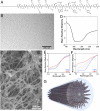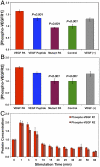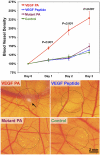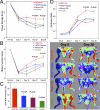Supramolecular nanostructures that mimic VEGF as a strategy for ischemic tissue repair
- PMID: 21808036
- PMCID: PMC3158182
- DOI: 10.1073/pnas.1016546108
Supramolecular nanostructures that mimic VEGF as a strategy for ischemic tissue repair
Erratum in
- Proc Natl Acad Sci U S A. 2012 Jun 5;109(23):9219
Abstract
There is great demand for the development of novel therapies for ischemic cardiovascular disease, a leading cause of morbidity and mortality worldwide. We report here on the development of a completely synthetic cell-free therapy based on peptide amphiphile nanostructures designed to mimic the activity of VEGF, one of the most potent angiogenic signaling proteins. Following self-assembly of peptide amphiphiles, nanoscale filaments form that display on their surfaces a VEGF-mimetic peptide at high density. The VEGF-mimetic filaments were found to induce phosphorylation of VEGF receptors and promote proangiogenic behavior in endothelial cells, indicated by an enhancement in proliferation, survival, and migration in vitro. In a chicken embryo assay, these nanostructures elicited an angiogenic response in the host vasculature. When evaluated in a mouse hind-limb ischemia model, the nanofibers increased tissue perfusion, functional recovery, limb salvage, and treadmill endurance compared to controls, which included the VEGF-mimetic peptide alone. Immunohistological evidence also demonstrated an increase in the density of microcirculation in the ischemic hind limb, suggesting the mechanism of efficacy of this promising potential therapy is linked to the enhanced microcirculatory angiogenesis that results from treatment with these polyvalent VEGF-mimetic nanofibers.
Conflict of interest statement
The authors declare no conflict of interest.
Figures





References
-
- Lloyd-Jones D, et al. Heart disease and stroke statistics—2009 update: A report from the American Heart Association Statistics Committee and Stroke Statistics Subcommittee. Circulation. 2009;119:480–486. - PubMed
-
- Folkman J. Angiogenesis: An organizing principle for drug discovery? Nat Rev Drug Discov. 2007;6:273–286. - PubMed
-
- Ferrara N, Gerber HP, LeCouter J. The biology of VEGF and its receptors. Nat Med. 2003;9:669–676. - PubMed
-
- Yla-Herttuala S, Rissanen TT, Vajanto I, Hartikainen J. Vascular endothelial growth factors: Biology and current status of clinical applications in cardiovascular medicine. J Am Coll Cardiol. 2007;49:1015–1026. - PubMed
Publication types
MeSH terms
Substances
Grants and funding
- R01 HL077428/HL/NHLBI NIH HHS/United States
- 1R01-EB003806-04/EB/NIBIB NIH HHS/United States
- R01 HL080137/HL/NHLBI NIH HHS/United States
- HL-57516/HL/NHLBI NIH HHS/United States
- HL-53354/HL/NHLBI NIH HHS/United States
- P01 HL066957/HL/NHLBI NIH HHS/United States
- P01HL-66957/HL/NHLBI NIH HHS/United States
- 5T90-DA022881/DA/NIDA NIH HHS/United States
- R37 HL053354/HL/NHLBI NIH HHS/United States
- R01 EB003806/EB/NIBIB NIH HHS/United States
- HL-63414/HL/NHLBI NIH HHS/United States
- R01 HL053354/HL/NHLBI NIH HHS/United States
- R01 HL057516/HL/NHLBI NIH HHS/United States
- HL-095874/HL/NHLBI NIH HHS/United States
- R01 HL063414/HL/NHLBI NIH HHS/United States
- HL-80137/HL/NHLBI NIH HHS/United States
- T90 DA022881/DA/NIDA NIH HHS/United States
- HL-77428/HL/NHLBI NIH HHS/United States
- P01HL-108795/HL/NHLBI NIH HHS/United States
LinkOut - more resources
Full Text Sources
Other Literature Sources

